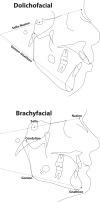Mechanobehavior and mandibular ramus length in different facial phenotypes
- PMID: 33378519
- PMCID: PMC8028425
- DOI: 10.2319/032420-217.1
Mechanobehavior and mandibular ramus length in different facial phenotypes
Abstract
Objectives: To test the hypotheses that mechanobehavior scores (MBS) were correlated with mandibular ramus lengths (Co-Go) and differed between facial phenotypes.
Materials and methods: Subjects gave informed consent to participate. Co-Go (mm), mandibular plane angles (SN-GoGn, °), and three-dimensional anatomy were derived from cephalometric radiography or cone beam computed tomography. Temporomandibular joint (TMJ) energy densities (ED) (mJ/mm3) were measured using dynamic stereometry and duty factors (DF) (%) were measured from electromyography, to calculate MBS (= ED2 × DF,) for each TMJ. Polynomial regressions, K-means cluster analysis, and analysis of variance (ANOVA) with Tukey post-hoc tests were employed.
Results: Fifty females and 23 males produced replete data. Polynomial regressions showed MBS were correlated with Co-Go (females, R2 = 0.57; males, R2 = 0.81). Cluster analysis identified three groups (P < .001). Dolichofacial subjects, with shorter normalized Co-Go, clustered into two subgroups with low and high MBS compared to brachyfacial subjects with longer Co-Go. SN-GoGn was significantly larger (P < .03) in the dolichofacial subgroups combined (33.0 ± 5.9°) compared to the brachyfacial group (29.8 ± 5.5°).
Conclusions: MBS correlated with Co-Go within sexes and differed significantly between brachyfacial and dolichofacial subjects.
Keywords: Craniofacial form; EMG; Human; Jaw mechanics; Masticatory muscles; TMJ.
© 2020 by The EH Angle Education and Research Foundation, Inc.
Figures





 ) in females and males. (B) Cluster analysis showed normalized Co-Go vs MBS centroid distances segregated a group with brachyfacial features from two subgroups with dolichofacial features.
) in females and males. (B) Cluster analysis showed normalized Co-Go vs MBS centroid distances segregated a group with brachyfacial features from two subgroups with dolichofacial features.Similar articles
-
A theoretical analysis of longitudinal temporomandibular joint compressive stresses and mandibular growth.Angle Orthod. 2022 Jan 1;92(1):11-17. doi: 10.2319/012921-84.1. Angle Orthod. 2022. PMID: 34383033 Free PMC article.
-
Jaw mechanics in dolichofacial and brachyfacial phenotypes: A longitudinal cephalometric-based study.Orthod Craniofac Res. 2017 Jun;20 Suppl 1:145-150. doi: 10.1111/ocr.12174. Orthod Craniofac Res. 2017. PMID: 28643908
-
Mechanobehaviour in dolichofacial and brachyfacial adolescents.Orthod Craniofac Res. 2017 Jun;20 Suppl 1:139-144. doi: 10.1111/ocr.12148. Orthod Craniofac Res. 2017. PMID: 28643919
-
Mechanobehavioral Scores in Women with and without TMJ Disc Displacement.J Dent Res. 2017 Jul;96(8):895-901. doi: 10.1177/0022034517704375. Epub 2017 Apr 17. J Dent Res. 2017. PMID: 28414608 Free PMC article.
-
Mechanobehavior and Ontogenesis of the Temporomandibular Joint.J Dent Res. 2018 Oct;97(11):1185-1192. doi: 10.1177/0022034518786469. Epub 2018 Jul 13. J Dent Res. 2018. PMID: 30004817 Free PMC article. Review.
Cited by
-
Mechanics- and Behavior-Related Temporomandibular Joint Differences.J Dent Res. 2024 Oct;103(11):1083-1090. doi: 10.1177/00220345241265670. Epub 2024 Sep 14. J Dent Res. 2024. PMID: 39275985
-
A theoretical analysis of longitudinal temporomandibular joint compressive stresses and mandibular growth.Angle Orthod. 2022 Jan 1;92(1):11-17. doi: 10.2319/012921-84.1. Angle Orthod. 2022. PMID: 34383033 Free PMC article.
-
Evaluation of associations between condylar morphology, ramus height, and mandibular plane angle in various vertical skeletal patterns: a digital radiographic study.BMC Oral Health. 2022 Aug 8;22(1):330. doi: 10.1186/s12903-022-02365-1. BMC Oral Health. 2022. PMID: 35941596 Free PMC article.
-
Associations between condylar height relative to occlusal plane and condylar osseous condition and TMJ loading based on 3D measurements and finite element analysis.Sci Rep. 2024 Nov 22;14(1):28919. doi: 10.1038/s41598-024-80442-x. Sci Rep. 2024. PMID: 39572697 Free PMC article.
References
-
- Buschang PH, Roldan SI, Tadlock LP. Guidelines for assessing the growth and development of orthodontic patients. Semin Orthod. 2017;23:321–335.
-
- Karlsen AT. Association between facial height development and mandibular growth rotation in low and high MP-SN angle faces: a longitudinal study. Angle Orthod. 1997;67:103–110. - PubMed
-
- Pancherz H, Michailidou C. Temporomandibular joint growth changes in hyperdivergent and hypodivergent Herbst subjects. A long-term roentgenographic cephalometric study. Am J Orthod Dentofacial Orthop. 2004;126:153–161. quiz 254–155. - PubMed
MeSH terms
LinkOut - more resources
Full Text Sources
Miscellaneous

